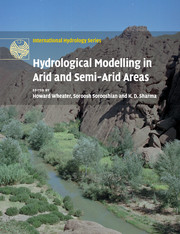Book contents
- Frontmatter
- Contents
- List of contributors
- Preface
- Acknowledgements
- 1 Modelling hydrological processes in arid and semi-arid areas: an introduction
- 2 Global precipitation estimation from satellite imagery using artificial neural networks
- 3 Modelling semi-arid and arid hydrology and water resources: The southern Africa experience
- 4 Use of the IHACRES rainfall-runoff model in arid and semi-arid regions
- 5 KINEROS2 and the AGWA modelling Framework
- 6 Ephemeral flow and sediment delivery modelling in the Indian arid zone
- 7 The modular modelling system (MMS): a toolbox for water and environmental resources management
- 8 Calibration, uncertainty, and regional analysis of conceptual rainfall-runoff models
- 9 Real-time flow forecasting
- 10 Real-time flood forecasting: Indian experience
- 11 Groundwater modelling in hard-rock terrain in semi-arid areas: experience from India
- Appendix Access to software and data products
- Index
- Plate section
- References
8 - Calibration, uncertainty, and regional analysis of conceptual rainfall-runoff models
Published online by Cambridge University Press: 15 December 2009
- Frontmatter
- Contents
- List of contributors
- Preface
- Acknowledgements
- 1 Modelling hydrological processes in arid and semi-arid areas: an introduction
- 2 Global precipitation estimation from satellite imagery using artificial neural networks
- 3 Modelling semi-arid and arid hydrology and water resources: The southern Africa experience
- 4 Use of the IHACRES rainfall-runoff model in arid and semi-arid regions
- 5 KINEROS2 and the AGWA modelling Framework
- 6 Ephemeral flow and sediment delivery modelling in the Indian arid zone
- 7 The modular modelling system (MMS): a toolbox for water and environmental resources management
- 8 Calibration, uncertainty, and regional analysis of conceptual rainfall-runoff models
- 9 Real-time flow forecasting
- 10 Real-time flood forecasting: Indian experience
- 11 Groundwater modelling in hard-rock terrain in semi-arid areas: experience from India
- Appendix Access to software and data products
- Index
- Plate section
- References
Summary
INTRODUCTION
The majority of continuous-time rainfall-runoff models can be classified as conceptual, as discussed in Chapter 1 (see also Wheater et al., 1993; Wheater, 2002). This type of model represents the hydrological processes that are seemingly important in the system using a simplified, conceptual representation (Fig. 8.1). These models have three notable characteristics: (a) their model structure is specified a priori, (b) the hydrological properties of the catchments are represented as parameters, which are generally assumed to be constant during each model application, (c) (at least some of) the model parameters have no direct, physical meaning and are not directly measurable. Therefore model parameters are usually estimated via calibration, using the fit of the model output time series to observed data to provide a measure of goodness of fit.
In this chapter we introduce the issues associated with calibration, and recent developments that allow the associated uncertainty to be specified. Finally the application of models to ungauged catchments (regional analysis) is discussed. For a more extensive treatment of these subjects, the reader is referred to Rainfall-Runoff Modelling in Gauged and Ungauged Catchments by Wagener et al. (2004) and also the AGU Monograph on Calibration of Watershed Models (Duan et al., 2003).
Information
- Type
- Chapter
- Information
- Hydrological Modelling in Arid and Semi-Arid Areas , pp. 99 - 112Publisher: Cambridge University PressPrint publication year: 2007
References
Accessibility standard: Unknown
Why this information is here
This section outlines the accessibility features of this content - including support for screen readers, full keyboard navigation and high-contrast display options. This may not be relevant for you.Accessibility Information
- 1
- Cited by
